This is Part 2 of 3 about my current favorite quilt that I’ve made, “Fusion,” pictured below. I made it in 2017, after letting it percolate for about 18 months. If you haven’t read Part 1 of this series, it’s going to seem like I’m starting in the middle. So go here and read that first — I’ll wait.
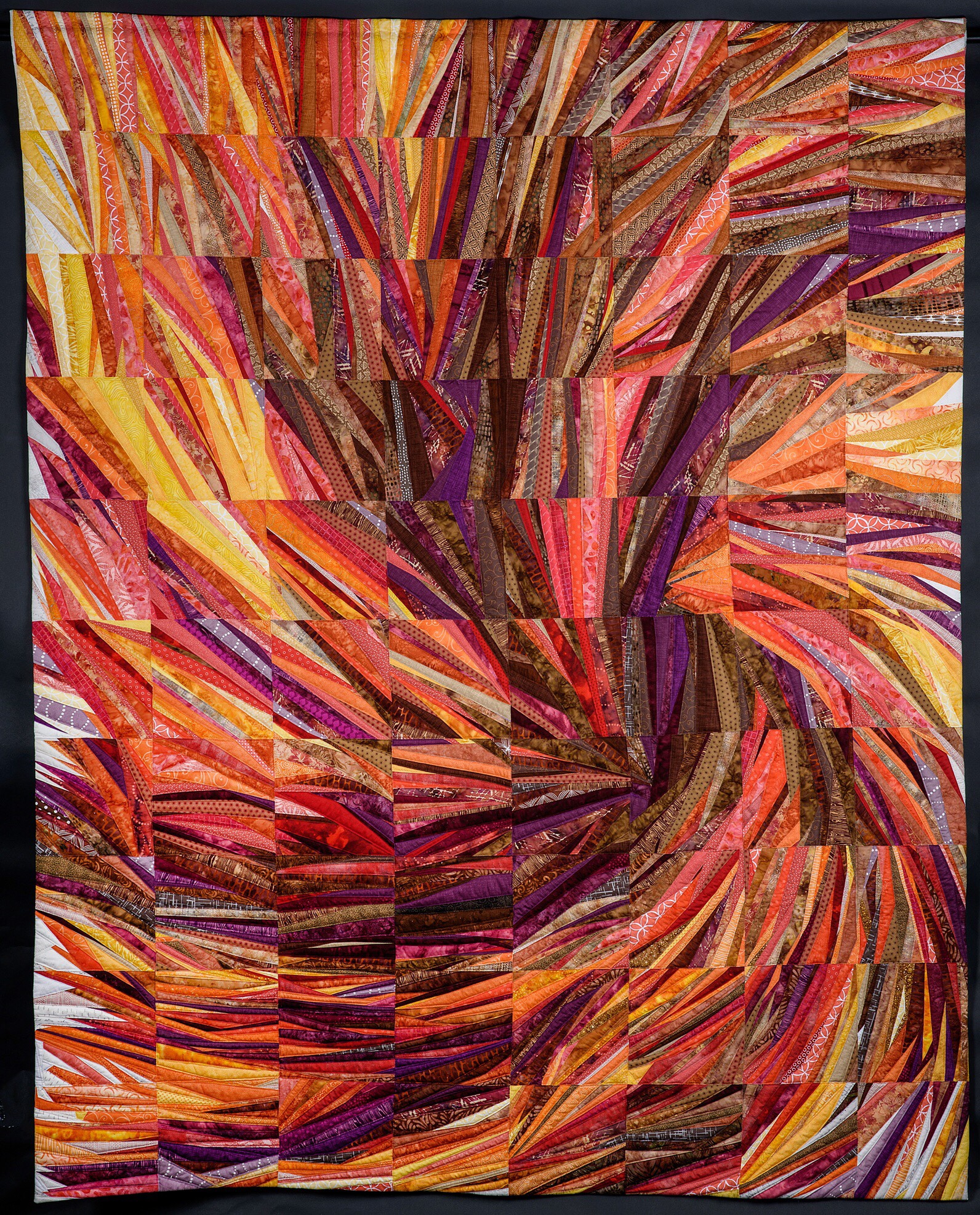
Photo by Jeff White Photography
Where were we? Oh, yes.
In late evening one night in March of 2017, over a year after Dad’s heart surgery, I was packing to go on a school trip and suddenly had a compulsive need to sketch out the complete design idea for the quilt.
There used to be a page in my Facebook profile where I collected favorite quotations… it has been swallowed up by webgremlins because I can’t find it, and I can’t remember enough of the quotation I want to mention here, but maybe one of you will know it. Basically, it’s suggesting that when you make art (and I think the originator was talking about composing music, but to me it’s the same), it’s because the act of not making the art is no longer tenable.
I HAD to pick up my pencils that night, and even though I was tired after standing all day, I was so moved to sketch this out that I stood up for almost two hours getting it drawn. I could have taken my pencils to the kitchen table and sat down, but the idea flood was coming so fast I didn’t want to even take a break for that… So I just kept sketching.
After two hours and increasing “ahems” from Jerry reminding me that I had to get up really early the next morning, I had drawn this in my large Moleskine cahier journal. I darkened the one inch grid lines and numbered the squares later.

I went on the trip and dreamed about this quilt idea, looking forward to coming back and working on it. But the more I daydreamed about it, the more I realized that I didn’t need to be dealing with the fractured thinking that the school year causes while I was trying to work through this piece. So I just let it marinate for the rest of the spring, pulling the fabrics from my stash and collecting them in a Sterilite bin. As soon as graduation was over, I eagerly began construction.
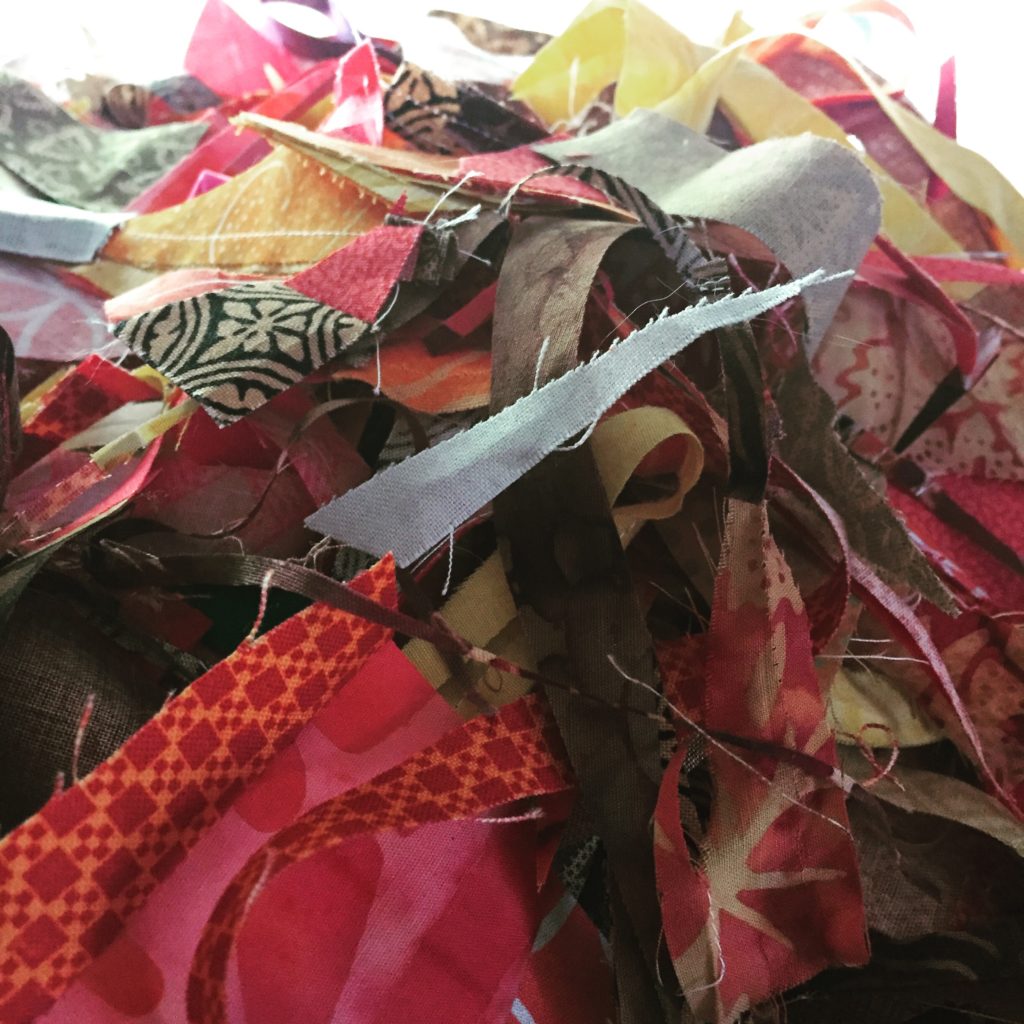
I cut 2.5″ strips of all of these fabrics, and piled them up on my table, working to assemble the colors in the same organic manner as in each block of the sketch. I did not use foundations to assemble the blocks, relying instead on spray starch and firmly pressing every seam before I trimmed and added the next piece. Sometimes I’d get the angles a little weird and would have to trim off a section and begin again, but I rarely used my seam ripper to fix errors; I just would trim more and try again.
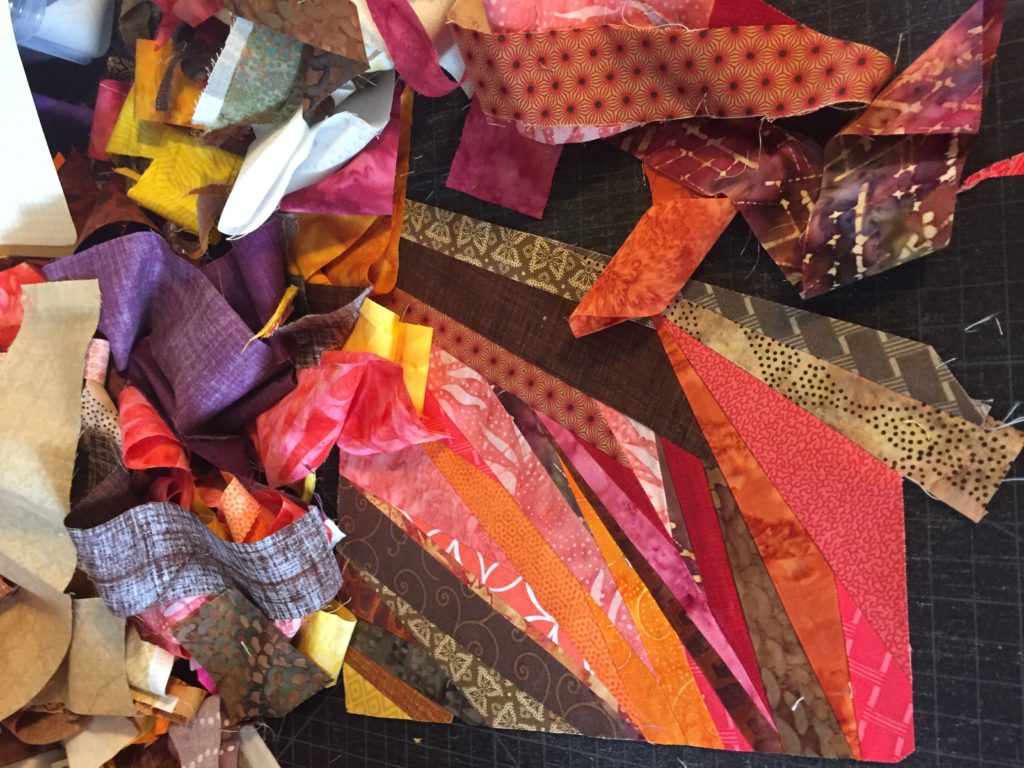
I also decided that any non-solid quilting cotton was fair game to use in the piece, no matter what genre of fabric was touching it. This meant that batiks danced with modern fabrics, and Thimbleberries mingled with hand-dyes and tonals. I expected to be struck down by Zeus himself because the! very! idea! of mixing batik fabrics with modern fabrics was enough to make some quilters hyperventilate about my heretic behavior.
No lightning came through my windows, so I kept going… Soon I had the top row fully assembled.

At this point I was getting kind of giddy about how it was going, but I was also a bit uncertain about if it would continue to be so cool as it got bigger. I told Jerry, as I often tell him when embarking on a fabric experiment:
This is either going to be really cool or a SPECTACULAR waste of fabric.
Occasionally the experiments end up being the latter, but usually if I can persist I find that they’re the former. The key is to push through the doubt when I start to hate it, and I’ll always start to hate it. It’s part of the process, and the part where most people get stuck and quit.

I probably squealed when I got the first few blocks of the second row done. When I had more of the second row finished, I knew that this was very definitely going to work, and it was going to be even better than I had imagined.

In the photo above, you can see that there are gaps in the blocks that have been finished and assembled on the wall. This is because I decided to work on two non-consecutive blocks at a time, so that a block wouldn’t inform the block next to it in design or fabric selection. I knew that I had very limited quantities of some of the fabrics I would be using, and I didn’t want to have to worry when I couldn’t find a fabric anymore — and some of these fabrics had been aging on my shelves for almost 2 decades. I also didn’t want to feel discouraged from using any fabric up completely. Didn’t I buy it to use it in the first place?
My process was to use Post-it Notes to cover all of the surrounding blocks, so that I could only see the block I was working on. Because of the size of my Post-it Notes, it was best to work on the blocks that were 3 apart. In the photo below you can see the marked sketch and the two visible blocks.

I’d usually work until the shreds of fabric had so encroached my workspace that I was struggling to find anywhere to work, and then I’d clean up until I had about a 16″ square of workable area again. This was right after a big cleanup session, as evidenced by the minimum of tiny shreds of fabric littering the left side of the cutting mat.
I referred to the sketch constantly to know what color fabric to choose next, and to get the angle on the last piece attached right — and to be sure to include enough seam allowance when I trimmed that I didn’t lose the last colors added.


Above are block 70 from the sketch, and block 70 from the quilt. The fabric version wasn’t a perfect duplicate of the sketch, but I decided that I liked the fracture lines caused by these types of imperfection.
It took about a day to assemble two blocks, and more if I made mistakes that I had to trim off and redo.
After I had two rows totally finished, the girls and I drove to Virginia for cousin Lauren’s high school graduation in the middle of June. We stayed in Wytheville, VA on the way up, and I bargained with the girls about fabric shopping at Sew What Fabrics, which is one of my favorite fabric stores in the world. They allowed (ha!) me to go as long as I picked up breakfast for them on the way back and didn’t stay longer than half an hour.
Turns out you can buy a LOT of fabric in half an hour.
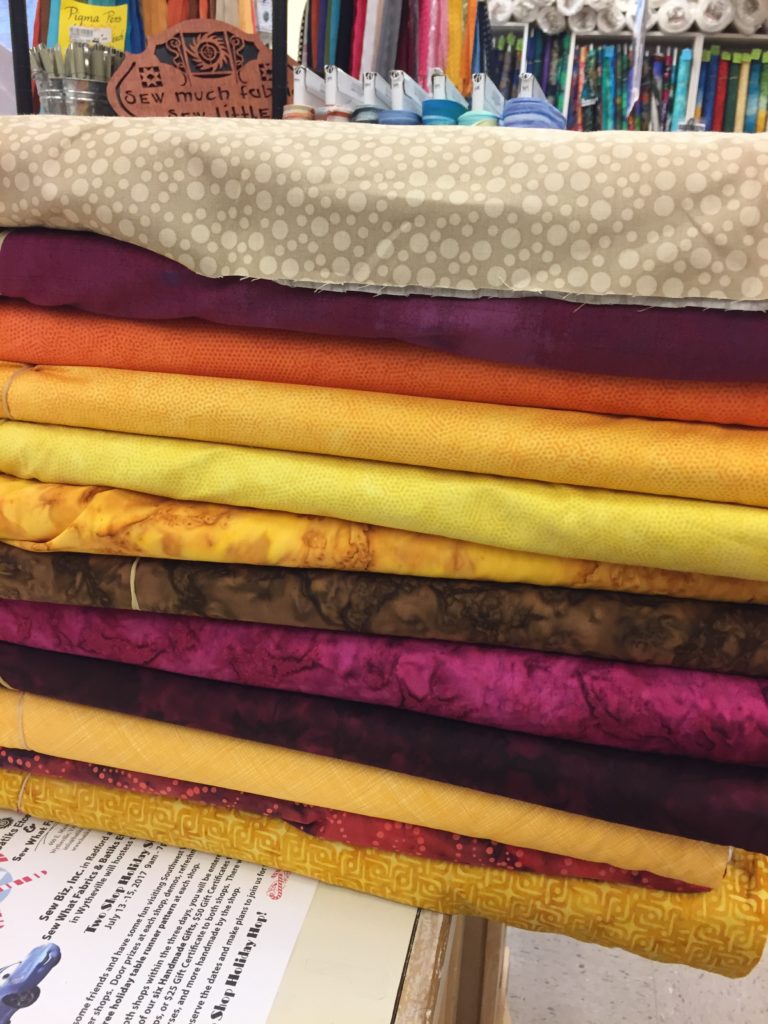
And this doesn’t even count the fat quarters of brown Civil War fabrics that I found… I don’t even remember how many of those there were, but it was good handful. I had pretty much run out of yellows and browns and maroons, and I still had 80% of the quilt remaining to assemble, most of which would need brown and maroon.
I told Helen I spent $11.00. I didn’t tell her the multiple of $11.00 that I spent, but she’s well aware of how much fabric costs so I’m pretty sure she was over there judging the stack and making calculations, preparing to rat on me to her daddy… who, as long as I use it up, really doesn’t care that much when I buy fabric.
In Virginia, we noticed that Dad was coughing a lot, and was grumpier and grumpier again — like he had been 2 years before. His coughs were dry and unproductive, and just sounded like they hurt. He’d get winded just walking around my brother’s house, and kept taking long naps. We just rolled our eyes and barked back at him when he was cranky, but something wasn’t right. He insisted he was fine, and at his annual physical appointment that week his doc had also said he was fine.
After our weekend in Virginia and safely back home again with the newly restocked yellows and maroons and browns, I kept working on assembling the rows.
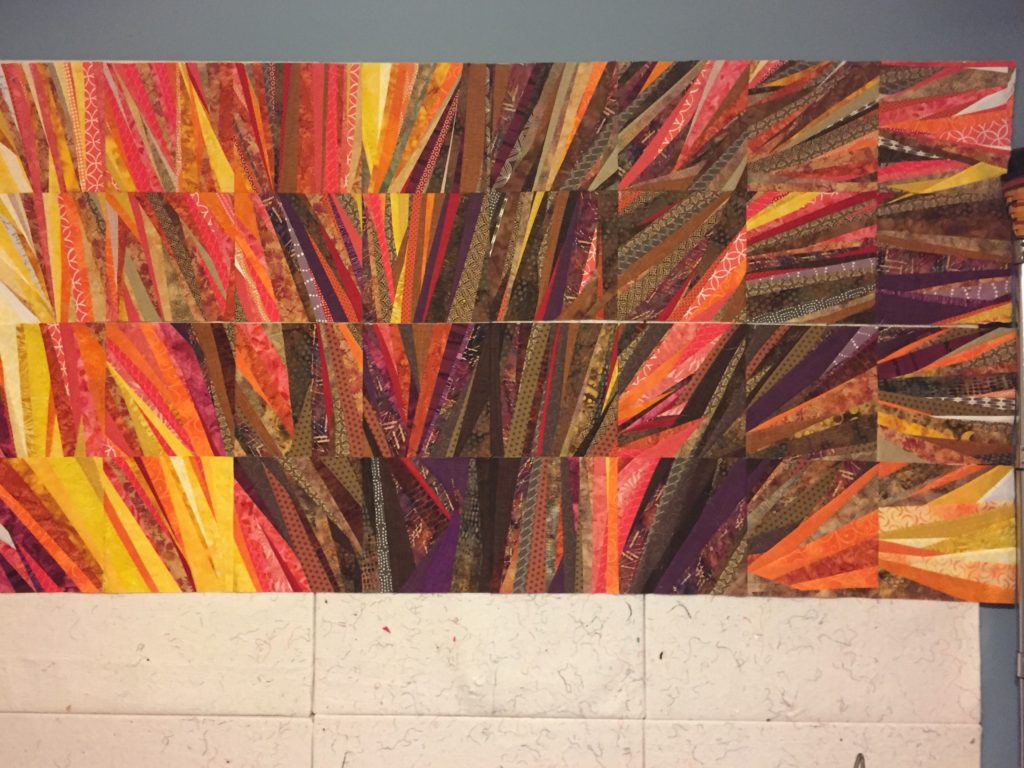
I’d post progress photos on Instagram and people kept suggesting that it looked like a fire. I didn’t confirm or deny what it represented for me, but the working title when Jerry and I would talk about it was “Arterial Spray.” We decided that perhaps that wasn’t a good name for a quilt, because it might invite questions. Lots and lots of questions.
I might watch too many crime TV shows. Perhaps.
I did finally post a photo of the first four rows of the sketch shown with the first four rows of the quilt, and the response was HUGE. “DO YOU TEACH CLASSES IN THIS!?!” Um, I’m figuring out what the heck I’m doing at the moment… lemme get back to you on that.

After I had 5 rows finished, I considered stopping… But I wasn’t out of fabrics yet and I had JUST spent $11.00, so I kept going.

I ran out of design wall, but I kept going. When I finished the piece, it extended two feet below my design wall and weighed more than most of the quilts I make. There were three cans of starch stabilizing everything and well over 2500 individual pieces of fabric sewn together.
Yes. I counted. Well, sort of. There are 252 pieces in the top row. As I got more comfortable with the process, the blocks got a lot more complex and had more pieces in them, and there are ten rows. So I know that there are more than 2500 pieces in it.
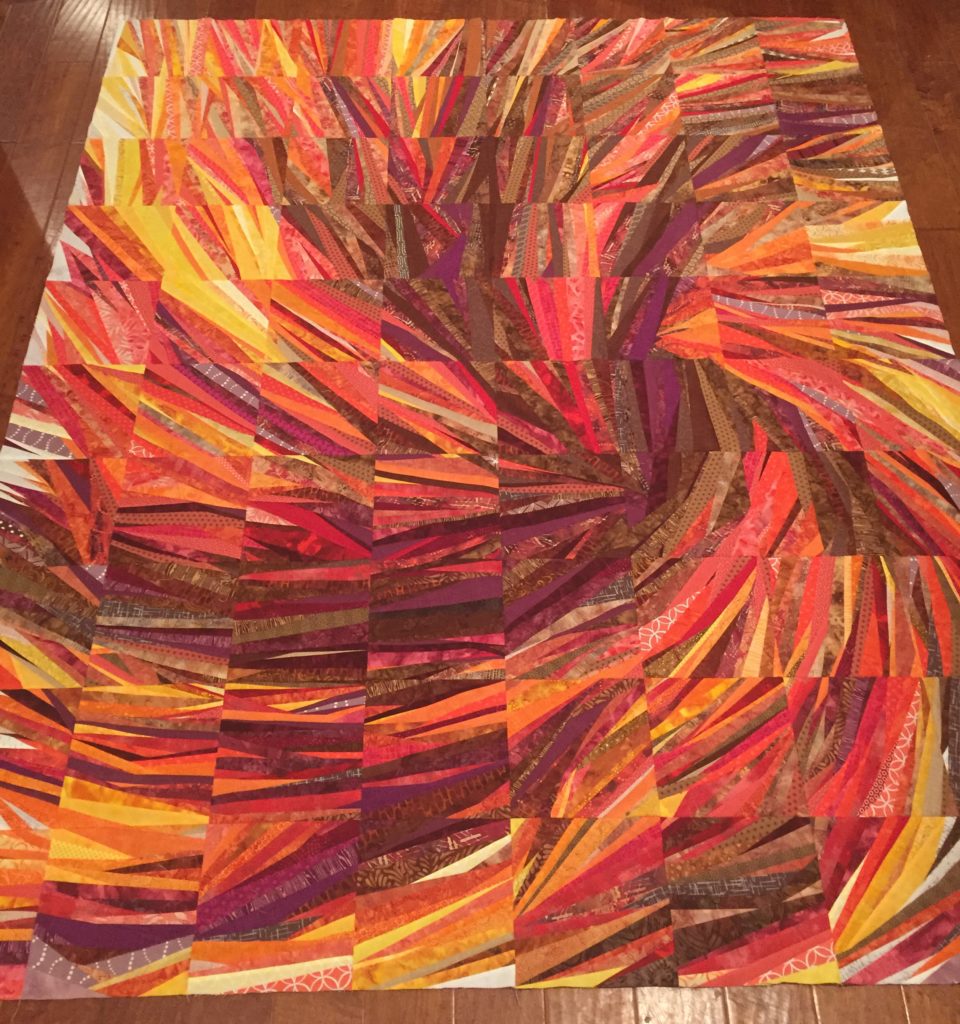
I couldn’t even get a photo of the entire thing without hanging off of the ledge over our foyer, but I was in too much of a hurry to get it onto my longarm quilting machine to take a good photo. By now it was August and I was about to have to go back to school. And our local guild’s biannual quilt show entry deadline was in the middle of August, so I needed to have a photo of it for color references in order to enter it into the show. To do the quilting justice, I also knew I was going to need as much of the remaining two months as possible to get it right.
I eagerly loaded the quilt onto the longarm machine with a layer of cotton and another layer of wool batting, basted the top edge to hold it in place, and chose my thread colors.


Mom and Dad had just come back from an RV caravan trip to Albuquerque, and their friends again had expressed concern about Dad’s declining ability to keep up. So they went to the doctor again, who said that this time he heard something weird when Dad was breathing. He was sent for a chest X-ray and CT scan. We waited for news and I went back to school for the faculty in-service training.
On August 6, Dad got a diagnosis: Stage 4 Lung Cancer. He had smoked for about 30 years, finally quitting when I was in high school. He worked in a woodworking shop as his hobby, and who knows what all that sawdust did to him. He loved campfires, and much of our family lore is from stories around a campfire. He had always had a wheezing cough, so that wasn’t all that new. What was new was how out of breath he would get, even when doing things like coming down the stairs after a nap. “Dad, that’s not normal,” was something I said to him often that summer. “You shouldn’t be winded from coming down the stairs.”
Suddenly this quilt had a much more important job to do, and its timeline was even more critical. Two things I knew for sure: I needed the therapy that would be provided by having this creative project, and I needed to finish it before Dad left or I would never finish it at all. Ideally, I wanted Dad to see it finished, since he was the original inspiration behind it, but I didn’t know what his prognosis was and how long it would take me to finish the quilt, so I couldn’t even guess if that was possible.

In Part 3 I’ll talk about the quilting process on “Fusion,” as well as the process of saying goodbye to my Daddy. Part 3 may take me a while to compose, but I’ll try to do it soon.
8 Responses
Thank you for talking through your process. I am learning a lot.
I especially related to what you said about, “be sure to include enough seam allowance when I trimmed that I didn’t lose the last colors added.” I keep doing that wrong and it bites me.
I am so sorry for your loss. I am proud of you for struggling through the grief work. It’s hard. So much harder than words can say.
That thing about the crime shows made me laugh out loud 🙂 I love this story, all of it. And I’m enthralled by the works of Ursula and Ann. Thanks!
How and why we create is fascinating. This documentation is fabulous, personal. Thank you for sharing your thoughts and technique. Really.
Very interesting. Thanks for sharing. I look forward to reading the next part.
I loved this quilt when it was posted on Instagram, it is stunning! Thank you for sharing with us the very personal story of how the quilt came into being. I admire your courage.
Love the colors and movement in this quilt.
I absolutely LOVE your quilt! Thank you so much for sharing your story…I’ve learned so much and as a brand new quilter, this has really inspired me to start my own journey.
I am reading your blog posts for the first time in March of 2022! You are a talented writer as well as a talented artist. Your posts just sucked me in before I knew what was going on. Your Fusion quilt first caught my eye because I am attracted to creative use of color. Please consider teaching. You have all the requisite skills; teacher, communicator, and artist. Bravo!